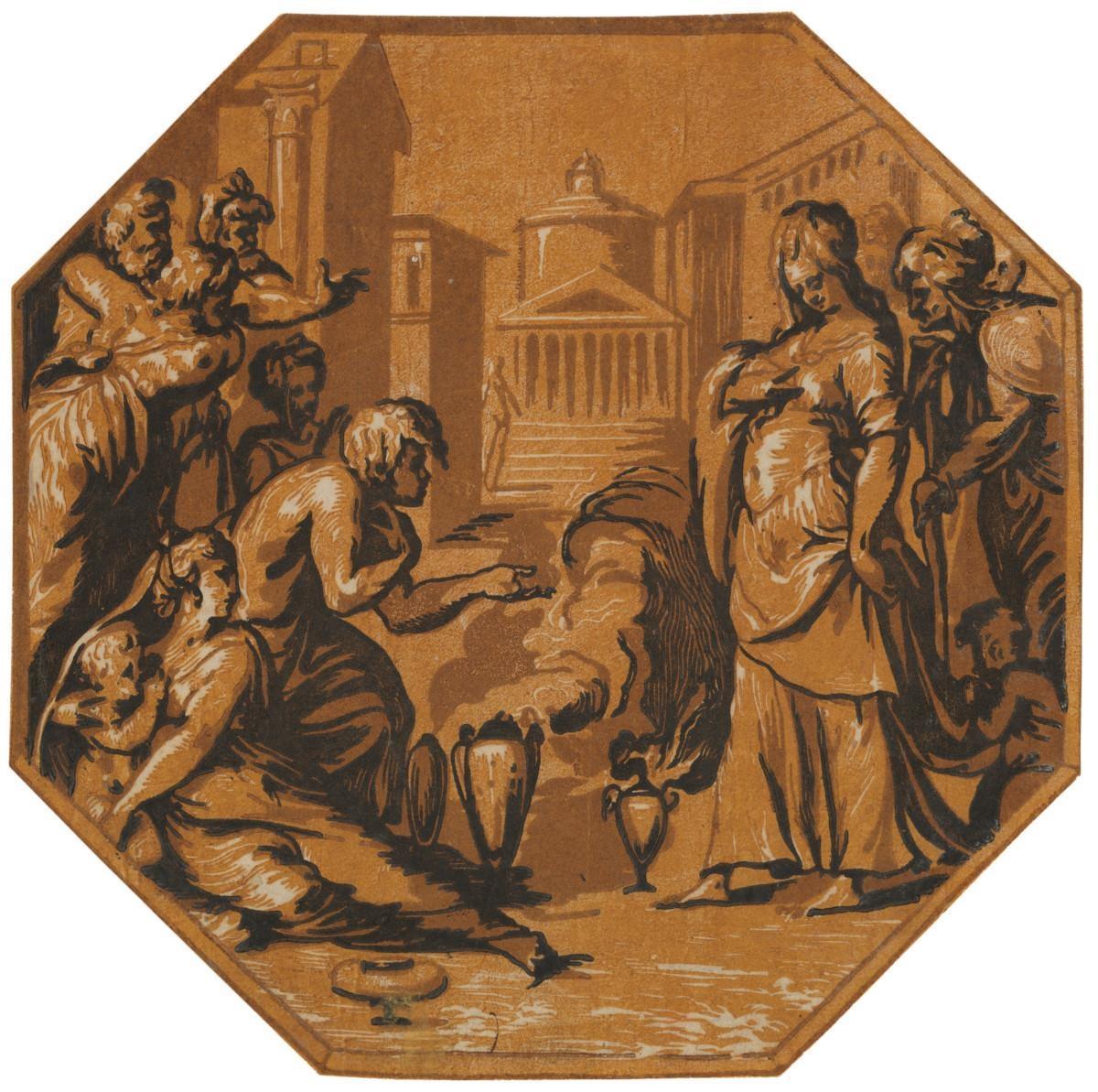OGGETTO
PROVENIENZA
DATAZIONE
AUTORE
STATO DELLA STAMPA
STATO DI CONSERVAZIONE
MODALITÀ DI CONSERVAZIONE
RESTAURI
ISCRIZIONI
STEMMI, MARCHI
NOTIZIE STORICO-CRITICHE
Chiaroscuro woodcut from 3 blocks, mustard ochre/sienna/black, i state
state i/ii: before Andreani's address
state ii/ii: “AA in Mantova 1602” added with a plug to the darkest block
Shortly after his arrival in Venice in the summer of 1539, Francesco Salviati (1510–1563) was at work on Honors Rendered to Psyche, an octagonal painting commissioned to adorn a ceiling in Giovanni Grimani's palazzo at Santa Maria Formosa. The palazzo housed an important collection of antiquities and was decorated with ancient themes, including the present subject from Apuleius's Metamorphoses depicting the beautiful princess Psyche admired by her citizens. Salviati's first major work in the city, the painting—thought to have been lost in the nineteenth century, until its recent rediscovery—received the superlative praise of his close friend and fellow Tuscan Giorgio Vasari, who described it as “the most beautiful work of painting that there is in all Venice”(Vasari-Bettarini and Barocchi 1966–87, vol. 5, p. 519). The print departs from the painting in a number of details: Psyche's stance and the position of her right hand are modified; the figure behind her is less tightly cropped and holds a stick absent in the painting; and the print's elaborate urban prospect replaces the isolated tempietto (small, round temple structure) and suggestions of ancient ruins (De Marchi 2004 and Craievich 2001). The differences between the print and finished painting may indicate that the blockcutter worked from a preliminary drawing of some kind. As Andrea De Marchi's study of the painting has revealed, Salviati made changes to the design in the course of its execution.
Although Salviati did not develop a lasting partnership with any single printmaker, he demonstrated an interest in having his designs disseminated in the form of prints throughout his career (on the prints after Salviati, see Mortari 1992). Vasari records how Salviati had left drawings in Bologna to be engraved by Girolamo Fagiuoli, just prior to his arrival in Venice (Vasari-Bettarini and Barocchi 1966–87, vol. 5, p. 518). While many prints after Salviati are both unsigned and undated, a number of them can be dated to the 1540s, including Honors Rendered to Psyche.
Pierre Jean Mariette correctly identified the unsigned print as the work of Niccolò Vicentino after Salviati (Mariette n.d., vol. 2, fol. 86). Some later writers, including Bartsch, have attributed the cutting to Antonio da Trento. However, in its partitioning of the design over three blocks, Honors Rendered to Psyche strongly resembles Vicentino's signed Christ Healing the Lepers. In both prints, the mid-block schematically renders architecture in the background, while the dark block reinforces outlines and shadows in the foreground to convey atmospheric perspective. The character of the cutting is also similar, with flowing contours and long, slightly wavering parallel lines of deep shading. Moreover, the delineation of highlights on the ground plane finds a close parallel in the signed Death of Ajax (ALU.0989.1).
Material facts also link Honors Rendered to Psyche to Vicentino's shop. LACMA 57.26.1 is printed in mustard ochre, sienna, and black inks. The Vicentino shop issued at least nine different compositions, including four of his signed works, in the same or similarly prepared inks and printed in an analogous fashion (the nine chiaroscuro woodcuts issued in this multi-woodcut edition are listed in Stiber Morenus 2015, 134–39; for all prints in this edition, the ink films are opaque, matte, moderately thick, and reticulated due to their high viscosity; each ink layer was dried before the next was printed and is thus discrete; the use of very moist paper and moderate to heavy printing pressure resulted in pronounced channeled squash, especially in the darkest block). To judge from the substantial number of impressions recorded in this palette, the Vicentino workshop favored these brown inks, composed of iron earths with calcium (iron earths are naturally occurring minerals containing clay and iron oxide. See Stiber Morenus et al. 2015). Some factors that may account for its popularity include the availability or affordability of the pigments, the ease of their use, and the demand of buyers.
The blocks were later republished by the Ladder in a Shield Printer, the Printer of Greek Text, and Andrea Andreani (see list below). The latter printed some impressions in the first state before adding his monogram in a second state, seen in LoC FP-XVI-V633, no. 65 (A size). The blocks show losses and are riddled with insect damage, most significantly in the lightest tone. To compensate, Andreani deployed exceptionally liquid inks that, though thinly applied, flowed into the lacunae of the blocks. The extreme channeled squash of these wash-like inks and deep embossment of the sheet reveal the impression was printed on very moist paper with heavy pressure and probably soft packing in the tympan. Andreani used similar printing procedures to reissue thirty prints that originated from Vicentino's shop (see Stiber Morenus 2015).
Naoko Takahatake, The Chiaroscuro Woodcut in Renaissance Italy, exhibition catalogue, Los Angeles County Museum of Art, June-September 2018, National Gallery of Art, Washington D.C, October 2018-January 2019, DelMonico Books/Prestel, Munich-London-New York, 2018, pp. 161-163.
Other Vicentino workshop impressions:
-Albertina DG2002/556: red/dark red/black https://sammlungenonline.albertina.at/m?queryid=984f912c-073f-49a3-8ca0-e7bc5f653837
-BM 1920,0216.5: red/brown/black https://www.britishmuseum.org/collection/object/P_1920-0216-5
-Albertina DG955: light gray-brown/green-brown/black https://sammlungenonline.albertina.at/m?queryid=a3416bb8-c6d5-4a92-a415-61713db777c5
-BM W,4.44: light gray-brown/green-brown/black https://www.britishmuseum.org/collection/object/P_W-4-44
-BM 1904,0226.16: light brown/brown/black https://www.britishmuseum.org/collection/object/P_1904-0226-16
-MMA 17.42.26: yellow/green/black https://www.metmuseum.org/art/collection/search/360144
-MFA 64.1109: lime/green/black https://collections.mfa.org/objects/168258/homage-rendered-to-psyche
-MFA M28193: light gray-brown/green-brown/black https://collections.mfa.org/objects/126961/homage-rendered-to-psyche
-Berlin 986-19: olive/brown/black
-BnF EA 26 boite: orange/dark orange/black
-BnF EA 26 boite: lime/green/black
-Budapest 6250: gray-green/gray/black http://printsanddrawings.hu/search/prints/6250/
-V&A E.946-88: mustard/brown/black
-Rijksmuseum RP-P-OB-31.069: http://hdl.handle.net/10934/RM0001.COLLECT.51371
Ladder in a Shield Printer in light brown/brown/black:
-Budapest 6252: http://printsanddrawings.hu/search/prints/6252/
-MFA 64.1137: https://collections.mfa.org/objects/167984/homage-rendered-to-psyche
-Albertina DG2002/557: https://sammlungenonline.albertina.at/m?queryid=a7aeb784-f780-4462-bc00-2f5bdc310589
-BM 1904,0226.16 (possibly) https://www.britishmuseum.org/collection/object/P_1904-0226-16
-BnF EA 26 boite (possibly)
Printer of Greek Text impressions in yellow ocher/brown/black:
-Rijksmuseum RP-P-OB-31.068: http://hdl.handle.net/10934/RM0001.COLLECT.51364
Example of Andreani impression state i/ii:
-BM 1860,0414.112 https://www.britishmuseum.org/collection/object/P_1860-0414-112
Example of Andreani impression state ii/ii:
-LoC FP-XVI-V633, no. 65 (A size)
: https://lccn.loc.gov/2008678933
Impressions to be determined:
- Kirk Edward Long Collection (two impressions, one of them trimmed in octagonal shape)
DOCUMENTAZIONE FOTOGRAFICA
REPERTORI
BIBLIOGRAFIA
https://www.thelacmastore.org/products/the-chiaroscuro-woodcut-in-renaissance-italy?_pos=1&_sid=ce2a0cc2a&_ss=r

